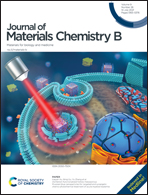An electrochemical biosensing platform for progesterone hormone detection using magnetic graphene oxide†
Abstract
In recent times, graphene and its derivatives have turned out to be emerging nanomaterials as transducers to promote electron transport in the field of biosensing using electrochemical techniques. In electrochemical biosensing strategies, key factors such as signal amplification, stability, and sensitivity are necessary for attaining improved sensor performance. In the present work, we synthesized magnetic nanocomposites of graphene oxide and employed them as an electrode material for the loading of bio receptors. The increased surface area with high electric conductance enhanced the sensor's response. The immobilization of progesterone (PGN) antibodies on the modified electrode-sensing surface led to a hindered electron transport that decreased the current response. The developed electrochemical immunosensor assembled successfully in a stepwise process using cyclic voltammetry (CV) and differential pulse voltammetry (DPV) studies along with the electrochemical impedance spectroscopy (EIS) analysis. The current response decreased linearly with the increased progesterone (PGN) concentration range of 0.01 pM–1000 nM with excellent detection limits of 0.15 pM (DPV) and 0.17 pM (CV) under optimal experimental conditions. The label-free electrochemical immunosensor has shown a promising platform for rapid and direct analysis of PGN due to its high sensitivity, selectivity, stability, and repeatability in water samples.

- This article is part of the themed collection: Journal of Materials Chemistry B HOT Papers


 Please wait while we load your content...
Please wait while we load your content...